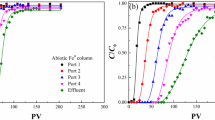Abstract
A biological method for the reduction Cr(VI), using sulphate-reducing bacteria (SRB), was tested in 2-L then 20-L fixed-bed reactors, with H2 as a low-cost and clean substrate. The systems were inoculated with Desulfomicrobium norvegicum, that proved to be particularly efficient for direct Cr(VI) enzymatic reduction. The bacterial reduction was efficient when some SO2− 4 was provided in the feeding, in order to allow their growth and to combine the direct enzymatic reduction to the indirect chemical reduction by dissolved H2S. The Cr(VI)/SO2− 4, ratio in the influent was adjusted in order to avoid excess sulphide production. A real polluted groundwater and an industrial electroplating effluent were treated in the 20-L pilot plant.
Similar content being viewed by others

References
Battaglia-Brunet, F., Foucher, S., Denamur, A., Ignatiadis, I., Michel, C. and Morin, D.: 2002, ‘Reduction of chromate by fixed films of sulfate-reducing bacteria using hydrogen as an electron source’, J. Ind. Microbiol. Biotechnol. 28, 154-159.
Chulsung, K., Gunhui, Z., Baolin, D., Thornton, E. C. and Huifang, X.: 2001, ‘Chromium(VI) reduction by hydrogen sulfide in aqueous media: stoichiometry and kinetics’, Environ. Sci. Technol. 35, 2219-2225.
Foucher, S., Battaglia-Brunet, F., Ignatiadis, I. and Morin, D.: 2001, ‘Treatment by sulfate-reducing bacteria of Chessy acid-mine drainage and metal recovery’, Chem. Eng. Sci. 56, 1639-1645.
McGrath, S. P. and Smith, S.: 1993, ‘Chromium and nickel’, in B. J. Alloway (ed.), Heavy Metals in Soils, Blackie Academic and Professional, Glasgow, UK, pp. 124-150.
Lovley, D. R. and Phillips, E. J. P.: 1994, ‘Reduction of chromate by Desulfovibrio vulgaris and its c3 cytochrome’, Appl. Environ. Microbiol. 60, 726-728.
Michel, C., Brugna, M., Aubert, C., Bernadac, A. and Bruschi, M.: 2001, ‘Enzymatic reduction of chromate: comparative studies using sulfate-reducing bacteria. Key role of polyheme cytochromes c and hydrogenases’, Appl. Microbiol. Biotechnol. 55, 95-100.
Pettine, M., Millero, F. J. and Passiro, R.: 1994, ‘Reduction of chromium (VI) with hydrogen sulfide in NaCl media’, Mar. Chem. 46, 335-344.
Petrilli, F. L. and de Flora, S.: 1977, ‘Toxicity and mutagenicity of hexavalent chromium in Salmonella typhimurium’, Appl. Environ. Microbiol. 33, 805-809.
Shroeder, H. A.: 1968, ‘The role of chromium in mammalian nutrition’, Am. J. Clin. Nut. 21, 230-244.
Tucker, M. D., Barton, L. L. and Thomson, B. M.: 1998, ‘Reduction of Cr, Mo, Se and U by Desul-fovibrio desulfuricans immobilized in polyacrylamide gels’, J. Ind. Microbiol. Biotechnol. 20, 13-19.
Author information
Authors and Affiliations
Rights and permissions
About this article
Cite this article
Battaglia-Brunet, F., Foucher, S., Morin, D. et al. Chromate (CrO2− 4) Reduction in Groundwaters by Using Reductive Bacteria in Fixed-Bed Bioreactors. Water, Air, & Soil Pollution: Focus 4, 127–135 (2004). https://doi.org/10.1023/B:WAFO.0000044792.16819.69
Issue Date:
DOI: https://doi.org/10.1023/B:WAFO.0000044792.16819.69



